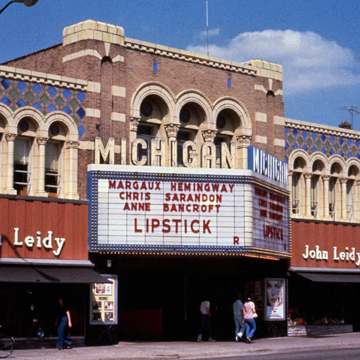The Michigan Theatre was the largest movie palace built in Ann Arbor. Constructed for local merchant Angelos Poulos, the building was leased to W. S. Butterfield, noted manager of theaters across the state. The auditorium seats 1,000. Finkel, formerly with Albert Kahn, designed the theater “to harmonize with the cultural atmosphere of the university,” using what he called a Romanesque motif, as reported in the Ann Arbor News (January 5, 1928). Otto Misch Company of Detroit built the theater; Tuttle and Clark Studio of Detroit did the interior. The exterior of the reinforced-concrete and brick building is clad with buff tapestry brick, ornately trimmed with terra-cotta arches, roped columns, and polychrome tiles. A grand staircase sweeps through the great barrel-vaulted lobby, which has walls and ceiling profusely decorated with rosette ornaments. The theater was equipped with a Burton Theater Pipe organ. The building also housed stores, offices, and bowling alleys.
Led by philanthropist and activist Margaret Dow Towsley and the Motor City Organ Society, citizens persuaded the City of Ann Arbor to purchase and restore the theater that had fallen into decline as a facility in which to stage the performing arts. The original features and surface details of the foyer and the auditorium, now magnificently gold leafed, recapture the theater's flamboyant expression of the attitudes and aspirations of the age in which it was built. In 2006 the League of Historic American Theaters named the Michigan Theatre the outstanding historic theater of the year.


